Jackie Damrau, Editor
Books Reviewed in This Issue
The reviews provided here are those that are self-selected by the reviewers from a provided list of available titles over a specific date range. Want to become a book reviewer? Contact Dr. Jackie Damrau at jdamrau3@gmail.com for more information.
Work Well From Home: Staying effective in the age of remote and hybrid working
Bloomsbury Business
Last But Not Least: A Guide to Proofreading Text
Leslie Vermeer
Keywords in Design Thinking: A Lexical Primer for Technical Communicators & Designers
Jason C.K. Tham, ed.
You Deserve a Tech Union
Ethan Marcotte
Translation Technology in Accessible Health Communication
Meng Ji, Pierrette Bouillon, and Mark Seligman
Mid-Century Type: Typography, Graphics, Designers
David Jury
Augmentation Technologies and Artificial Intelligence in Technical Communication: Designing Ethical Futures
Ann Hill Duin and Isabel Pedersen
Literary Theory for Robots: How Computers Learned to Write
Dennis Yi Tenen
Interactive Storytelling: A Cross-Media Approach to Writing, Producing and Editing with AI
Antonio Pizzo, Vincenzo Lombardo, and Rossana Damiano
Emoji and Social Media Paralanguage
Michele Zappavigna and Lorenzo Logi
Strategic Communication and AI: Public Relations with Intelligent User Interfaces
Simon Moore and Roland Hübscher
Same as Ever: A Guide to What Never Changes
Morgan Housel
Watch Your Language: Why Conversations Go Wrong and How to Fix Them
Rob Kendell
Falsehoods Fly: Why Misinformation Spreads and How to Stop It
Paul Thagard
Amplifying Voices in UX: Balancing Design and User Needs in Technical Communication
Amber L. Lancaster and Carie S. Tucker King, eds.
Learning to Imagine: The Science of Discovering New Possibilities
Andrew Shtulman
The Privacy Fallacy: Harm and Power in the Information Economy
Ignacio Cofone
How to Be a Digital Nomad: Build a successful career while travelling around the world
Kayla Ihrig
Life Before the Internet: What we can learn from the good old days
Michael Gentle
The Drive for Knowledge: The Science of Human Information Seeking
Irene Cogliati Dezza, Eric Schulz, and Charley M. Wu, eds.
Better Practices: Exploring the Teaching of Writing in Online and Hybrid Spaces
Amy Cicchino and Troy Hicks, eds.
The Visual Elements–Design: A Handbook for Communicating Science and Engineering
Felice C. Frankel
The Elements of Visual Grammar: A Designer’s Guide for Writers, Scholars & Professionals
Angela Riechers
Science v. Story: Narrative Strategies for Science Communicators
Emma Frances Bloomfield
Reimagine Inclusion: Debunking 13 Myths To Transform Your Workplace
Mita Mallick
I Cannot Control Everything Forever: A Memoir of Motherhood, Science, and Art
Emily C. Bloom
Technical Writing Process: Master the Art of Technical Communication with Timeless Techniques and Modern Tools
Alison Pickering, et al., ed
The Sound of Writing
Christopher Cannon and Steven Justice, eds.
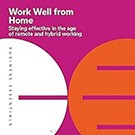 Work Well From Home: Staying effective in the age of remote and hybrid working
Work Well From Home: Staying effective in the age of remote and hybrid working
Bloomsbury Business. 2023. Bloomsbury Publishing. [ISBN 978-1-3994-0389-4. 96 pages, including index. US$14.00 (softcover).]
Work Well From Home: Staying effective in the age of remote and hybrid working is a self-help primer for workers transitioning to a remote work role. This book is aimed at workers considering full-time remote work, but some tips can be useful for those who occasionally work from home.
Working from home has benefits including a reduced commute, but the authors warn it is not for everyone. People who are extremely extroverted or who have trouble separating their work and home life should think carefully before making a switch to a remote work environment. If you choose remote work, you should create a dedicated environment with good lighting, comfortable furniture, and a door that closes you off from the rest of your home.
When making the transition to remote work, anticipate an adjustment period. You should set clear boundaries about your starting and ending times and establish a routine to begin your workday. This could be as simple as making a cup of coffee, closing your office door, and turning on your computer. The authors also warn not to yield to the temptation to work in your pajamas. Getting dressed in real clothes creates another psychological boundary between work and home life.
To prioritize your work time effectively, use tools like to-do lists and a calendar to keep track of milestones and deadlines. To maximize your focused time, you should also manage your inputs by limiting checking your email and phone to dedicated times throughout the day.
Communicate regularly with your key contacts: colleagues, bosses, customers, and so on. Reach out to establish and maintain a rapport by connecting with your co-workers on a personal level. Initiate a video call at the beginning of a relationship so you can see body language and hear tone to establish a good foundation for the relationship. Use collaboration tools to work together asynchronously between virtual meetings.
To combat isolation and maintain good relationships, make regular contact with your colleagues and friends. If you only communicate when you need something, contacts will dread taking your calls. Consider in-person meetings occasionally when feasible (meeting for lunch or coffee) and continue to attend valuable in-person events such as training and office parties as often as possible.
The final chapter covers striking out on your own as a freelancer or starting your own business. It seems out of place with the rest of the book and could have been omitted with no loss of value to the subject at hand.
Overall, Work Well from Home is a practical handbook for starting an effective remote work routine. I would recommend it to anyone who has recently transitioned to a remote role or is considering it.
Bonnie Winstel
Bonnie Winstel is a Project Analyst at Science Applications International Corporation (SAIC). She received her master’s degree in English and Technical Communication at the University of Alabama-Huntsville in 2013.
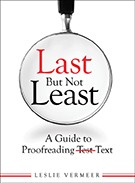 Last But Not Least: A Guide to Proofreading Text
Last But Not Least: A Guide to Proofreading Text
Leslie Vermeer. 2023. Brush Education Inc [ISBN 978-1-55059-787-5. 162 pages, including index. US$24.95(softcover).]
Leslie Vermeer, a writer, editor, and professor, with more than twenty years’ experience in book publishing, has a clear goal in writing Last But Not Least: A Guide to Proofreading Text: “The techniques and procedures in this book will teach you how to proofread your way to excellent documents” (p. xi). She has accomplished her goal by creating a comprehensive, user friendly, and practical guide to proofreading. Vermeer is Canadian and therefore uses Canadian spelling in the text and exercises. However, except for a few exercises focusing on spelling, this is a minor point and does not interfere with others’ use of this book.
New proofreaders, students, and experienced technical communicators who don’t proofread as part of their usual responsibilities will find this book to be a valuable resource. While experienced proofreaders might not need the instruction, they would find her explanations of proofreading tasks and their importance helpful when discussing their job with people not familiar with the proofreader’s role. The book is well organized and formatted, facilitating its use as an ongoing resource, and applies to paper and screen work.
Vermeer begins with defining proofreading and what it is not (including copyediting versus proofreading). This clarification is important as proofreading’s scope is sometimes misunderstood.
She explains, “Chapter 1 forms the foundation of the book. It provides specific instruction about how, when, and why we proofread, from where proofreading fits in the production sequence of documents to how to make proofreading marks” (p. xii). Chapters 2 to 6 are organized around a specific topic, such as “Spelling” (Chapter 2), “Punctuation and Mechanics” (Chapter 3), and “Proofreading Visual Communication” (Chapter 6). Chapter 7 concludes the topic with additional tips and advice for successful proofreading while Chapter 8 contains additional exercises. Additional resource material includes appendices, a glossary, and bibliography.
Each chapter begins with a brief exercise introducing the topic (“Warming up to Proofreading”), includes several exercises providing readers an opportunity to practice the skills discussed in a chapter, and ends with a “Building a Thorough Process” section that lists tips and techniques to help readers develop and strengthen their proofreading skills. Because the book’s readers will likely represent a broad spectrum of fields and jobs, the exercises are general and are not specific to technical communication. However, the skills practiced in the exercises apply to proofreading technical communication documentation which is not an issue.
Ann Marie Queeney
Ann Marie Queeney is an STC senior member with more than 20 years’ technical communication experience primarily in medical devices. Her STC experience includes Special Interest Group leadership, 2020-2022 Board member, CAC Chair, and Education committee member. Ann Marie is the owner of A.M. Queeney, LLC.
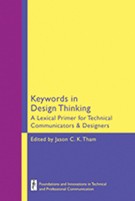 Keywords in Design Thinking: A Lexical Primer for Technical Communicators & Designers
Keywords in Design Thinking: A Lexical Primer for Technical Communicators & Designers
Jason C.K. Tham, ed. The WAC Clearing House and University of Colorado Press. [ISBN 978-1-64642-394-1. 166 pages. US$22.95 (softcover).]
Keywords in Design Thinking: A Lexical Primer for Technical Communicators & Designers is a comprehensive collection of short essays by scholars and practitioners that explores design thinking from a technical and professional communication perspective. In short, design thinking is “an approach for creating solutions to difficult problems…as well as a process for seeking resolutions to those problems” (p. 3). The first six essays focus on the design thinking process while the remaining 23 focus on various aspects of design thinking phases, concepts, and applications.
This interdisciplinary assemblage of essays spans a wide array of topics, from “wicked problems,” to creativity and inclusivity, with each essay being short and to the point. Tham arranged the essays in alphabetical order, which, unfortunately, makes it difficult to see the relationship between topics. For example, the essays on usability that include ideation, contextual inquiry, participatory design, and usability testing would be best grouped together under one collective heading, while the essays about equity, entrepreneurship, and social justice deserve another.
Each essay contains information on design applications. For example, the piece on rapid prototyping describes the development of a new phone case. The author describes different ways by which the case can be designed using paper or modeling clay to first determine the dimensions. He then recommends drafting a digital 3D file using CAD software. “This process,” the author notes, “allows the designer to isolate and test otherwise interdependent elements of a design and quickly deploy the product to its test or target market” (p. 38). This is good, sound advice about how to employ rapid prototyping.
Additionally, each essay contains a “Pedagogical Integration” section where the authors link the design idea to practical classroom applications. In the chapter on Participatory Design, for instance, the author recommends using inquiry, ethnography, card sorting, and focus groups to facilitate the understanding of how one can educate students in a participatory design approach to usability.
Keywords in Design Thinking is a highly academic book supported with extensive research. However, it could have been written with a more applied audience in mind for easier reading. The exhaustive level of academic jargon and copious references present a quagmire in which the reader can easily become disoriented. The book is still a useful primer for academics interested in a wide array of topics as they relate to technical communication and usability.
Lynne Cooke
Lynne Cooke is a Clinical Assistant Professor at Arizona State University where she teaches courses on usability, digital media, and portfolio development. She is also a member of the Arizona Chapter of STC and the Internship Coordinator at ASU.
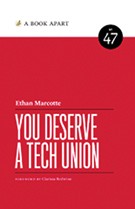 You Deserve a Tech Union
You Deserve a Tech Union
Ethan Marcotte. 2023. A Book Apart. [ISBN 978-1-952616-61-7. 167 pages, including index. US$36.00 (softcover).]
You Deserve a Tech Union couldn’t come at a better time. After years of decline, the labor movement is experiencing a resurgence, and tech companies and departments are beginning to respond.
As the book’s Foreword points out, labor exploitation is rampant in the tech industry and work life is precarious. Contract and “gig” work is exploited to exhaust workers and to deny them benefits and protections. “Perks” are used in place of equitable pay to encourage working long hours. Workers are subjected to mass layoffs that enrich management, while disempowering workers and depressing wages. Problems of discrimination, racism, sexism, and ageism are common. And the list goes on.
In You Deserve a Tech Union, Ethan Marcotte argues that the many ills that plague the tech workplace are due to wildly uneven disparities in power between employers and workers, and makes the case for resolving them through collective action and forming a labor union.
Throughout, Marcotte writes in a conversational tone, keeps it down to earth, and emphasizes the practical over the theoretical. Knowing that the idea of acting collectively may be new to many young tech workers, he covers just enough labor history to bring the reader up to speed. To make it personal, he asks readers to list the things they hate and love about their work. He then asks them to consider how little power they have to change what they hate, and how little they can trust that the things they love won’t go away at the whim of a manager, an erratic owner, or pressure from investors.
Based on interviews with tech union organizers, activists, economists, and others, Marcotte explains what unions are and why they matter—without a union, you don’t have a seat at the table—and covers the strategies and steps involved in forming a union. He walks the reader through each of the steps involved, from holding your first exploratory meetings, to forming an organizing committee, to managing the election process, to forming your bargaining committee and contract negotiations. He explains your rights during union formation, the rules governing union elections, and—once the union is certified—the contract negotiation process.
Marcotte also discusses the tactics and pushback that you can expect from management—hiring a union-busting firm, holding captive audience meetings, retaliation against organizers, and other efforts to create fear, uncertainty, and doubt. While the violence of early labor history has lessened, he notes, responses can still be economically and psychologically violent and workers need to be prepared. But with outreach, organizing, and building trust the challenges can be met.
You Deserve a Tech Union includes a list of additional resources covering labor history and the law, organizing guides and training, staying informed on labor issues, workplace surveillance and union busting, the problems of marginalized tech workers, and more.
Whether you are already involved in a union drive, or just want a better understanding of the options available in taking better control of your work environment, you owe it to yourself to read this book.
Patrick Lufkin
Patrick Lufkin is an STC Fellow with experience in computer documentation, newsletter production, and public relations. He reads widely in science, history, and current affairs, as well as on writing and editing. Patrick chairs the Gordon Scholarship for technical communication and co-chairs the Northern California technical communication competition.
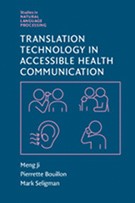 Translation Technology in Accessible Health Communication
Translation Technology in Accessible Health Communication
Meng Ji, Pierrette Bouillon, and Mark Seligman. Cambridge University Press. [ISBN 978-1-1088-3737-8. 300 pages, including index. US$84.99 (hardback).]
Translation Technology in Accessible Health Communication addresses one of the most pressing topics in health care facing the world today: How can we communicate effectively in the healthcare setting with patients who do not speak our language or who have communication difficulties? Meng Ji, Pierrette Bouillon, and Mark Seligman attempt to uncover the most current and effective ways to communicate with speakers of other languages as well as with patients with communication differences stemming from disabilities.
The perspective offered in Translation Technology is unique in that the authors are not unreservedly pro-technology, despite the many recent breakthroughs in machine translation (MT) and the dizzying possibilities for their use. Throughout the book, Ji et al. advise proceeding conservatively and with “informed caution,” especially given the potentially deadly consequences of translation errors for patients (p. 4). As an academic who has studied MT, I found this approach prudent as well as refreshing, and it enhanced my perception of the book’s credibility.
Aside from explaining how the different methods of MT work and the benefits and drawbacks of each, the book provides a roadmap for creating effective healthcare applications and websites when using MT technologies. Specifically, the authors advise making the applications transparent to make translation errors detectible, making the applications adaptable or customizable for the user or language group, making the applications inclusive for people with disabilities, and adhering to current accessibility standards (pp. 4–9).
The text is organized into a series of chapters that can be read as stand-alone passages or taken to get a broader picture of the current state of MT and its applications in the medical setting. For example, Chapter 6: Healthcare Accessibility for the Deaf – The BabelDr Case Study” would be an excellent selection for a disability studies class in technical or medical communication. Although some cross-referencing did occur between chapters when discussing terms introduced previously, the authors provide enough background for each term to make flipping back through the book unnecessary. The use of examples and visuals depicting these technologies and their interfaces was illuminating and well-illustrated. I could clearly understand what these applications did and how they functioned even without having them at hand to examine.
Translation Technology in Accessible Health Communication is sufficiently clear and well-explained enough to be useful for academics or technical writers in the health fields. Readers from a variety of backgrounds could appreciate Ji et al.’s well-reasoned analysis of the different types of MT available for use in medical settings. Similarly, graduate students in technical communication could benefit from learning about the emerging methods of MT and how these technologies are being used in medical settings.
Nicole St. Germaine
Nicole St. Germaine is a Professor of English and the Coordinator of the Technical and Business Writing Program at the Natalie Z. Ryan Department of English at Angelo State University.
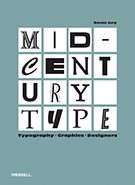 Mid-Century Type: Typography, Graphics, Designers
Mid-Century Type: Typography, Graphics, Designers
David Jury. 2023. Merrell Publishers. [ISBN 978-1-8589-4707-5. 240 pages, including index. US$55.00 (hardcover).]
Mid-Century Type: Typography, Graphics, Designers presents a deep dive into post-World War II design; arguably, this is when graphic design history begins in earnest, or at least the modern professional practice of graphic design. The contents include Type Design, Typographic Journals, Posters, Corporate Identity, Advertising, Magazines, Books, Transport, Film & Television, and Ephemera, focusing on a timeline from 1945 through the 1960s. However, some earlier content is presented to establish context for later work. Mid-Century Type is a beautiful book that is easy to read and offers an exclusive examination of a very specific period of history.
The book feels substantial and is beautifully designed. The contents are nicely laid out, full of attractive, high-quality images, and printed on luxurious paper. The clever use of the grid structure for the front cover, title page, and table of contents is worth noting; they are reminiscent of the grid used by Adrian Frutiger to identify the weights and variants of his mid-century typeface design Univers from 1957, featured on page 21. The abundance of images helps make the book a quick read, but it is also written in a way that is accessible with minimal technical language that would prevent readers from moving quickly through the content.
This deep dive into post-World War II design certainly presents more names than usual in this era of design history. However, the content is solidly within the canon in that it presents a white male Eurocentric view of graphic design history. The book only mentions a few influential women in this history: Beatrice Warde, Cipe Pineles, Elaine Lustig (Cohen), and Margaret Calvert. However, it does include several names of male designers that are not typically included in design histories. While the content on women is limited, it is thoughtful in how it presents their contributions and offers some context as to why we don’t see more women in this history; “women were denied entry to the printing industry by its unions” (p. 9). Still, it would have been good to acknowledge the contributions of more women, such as Elaine Bass who worked alongside her famous husband, Saul, included in the book. Additionally, the contributions of Georg Olden, a Black American designer for CBS Television, were omitted from the section on Film & Television. Indeed, it seems like no designers of color are present in the book. However, it should be acknowledged that they would have had limited access and barriers to entry in the professional field, like women.
Despite this criticism, Mid-Century Type is a wonderful addition to any collection on design history. The images presented make the book worth buying alone, but the approachable way the content is written is geared towards students and practitioners. It also includes good explanations about how technology shifted design practices and reminds us that history doesn’t have to be overly complicated in its presentation.
Amanda Horton
Amanda Horton holds an MFA in Design and teaches graduate and undergraduate courses at the University of Central Oklahoma (UCO) in design history, theory, and criticism. She is also the director of the Design History Minor at UCO.
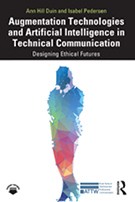 Augmentation Technologies and Artificial Intelligence in Technical Communication: Designing Ethical Futures
Augmentation Technologies and Artificial Intelligence in Technical Communication: Designing Ethical Futures
Ann Hill Duin and Isabel Pedersen. 2023. Routledge. [ISBN 978-1-003-28800-8. 282 pages, including index. US$48.95 (e-book).]
Augmentation Technologies and Artificial Intelligence in Technical Communication: Designing Ethical Futures delves into the intersection of augmentative technology and artificial intelligence (AI) by exploring their impact on the human experience and the ethical implications of enhancing identity and capability. This book provides valuable resources for researchers and professionals in technical communication, user experience (UX) design, and related fields, addressing brain-computer interfaces, robotics, wearables, and AI-powered emotional augmentation. Ann Hill Duin and Isabel Pedersen provide a comprehensive framework for understanding these technologies as well as resources for research and teaching.
Of relevance to technical communicators, the authors offer a detailed examination of the evolving role of technical communicators considering emerging technologies. They highlight the integration of augmentative technologies into UX design, providing practical guidance on how to incorporate these technologies into user documentation, API references, and adaptive help systems. Duin and Pederson then draw on interdisciplinary research to ensure accuracy and use the Fabric of Digital Life archive for an evidence-based approach. They advocate for a multidisciplinary approach to analyzing augmentation technologies, emphasizing the need for ethical frameworks and digital literacy to guide responsible design and adoption. Their perspective offers a socially conscious and well-substantiated analysis, broadening the understanding of this field beyond previous works.
One of the book’s key strengths is its focus on the practical application of augmentative technologies. Duin and Pedersen provide a comprehensive overview of the technologies as well as specific examples of how they can be used in real-world settings. This makes the book an invaluable resource for technical communicators and UX designers who are looking to incorporate these technologies into their work. Another strength is the multidisciplinary approach where the authors draw on a variety of disciplines, including technical communication, UX design, ethics, and sociology, to provide a well-rounded view of the topic. This approach makes the book an essential resource for anyone who wants to understand the social and ethical implications of augmentative technologies.
Overall, Augmentation Technologies and Artificial Intelligence in Technical Communication is a valuable resource for anyone interested in the ethical implications of augmentative technologies. It offers a comprehensive understanding of the field and a framework for evaluating such technologies. The book is well-written and easy to follow, making it accessible to a wide range of readers.
Danang Handoko Belut Saputro
Danang Handoko Belut Saputro is an awardee of the Lembaga Pengelola Dana Pendidikan (LPDP) PK-176 scholarship for a master’s degree in information technology at the Universitas Gadjah Mada in Indonesia. He is grateful to LPDP for providing complete financial support for his master’s degree and this book review.
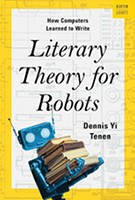 Literary Theory for Robots: How Computers Learned to Write
Literary Theory for Robots: How Computers Learned to Write
Dennis Yi Tenen. W. W. Norton & Company. [ISBN 978-0-393-88218-6. 158 pages, including index. US$22.00 (hardcover).]
With all the talk these days about artificial intelligence (AI) and machine learning, most people know that AI learns as it goes. A simple example is predictive text on your mobile phone or tablet. Based on the context of your message and the first letters you type, machine learning curates words and phrases that you often type and ranks them to guess when they might be used again. You can almost imagine AI consulting a word cloud, choosing the biggest and boldest word it sees, and offering it up as suggested text.
Dennis Yi Tenen describes how AI learns as it goes on a much bigger scale in Literary Theory for Robots: How Computers Learned to Write. He uses chapters one through five to explore the feeding and training of a collective machine conscience. Surely, it’s no surprise that he mentions the creations of Charles Babbage, Ada Lovelace, and Alan Turing in the history of computers.
Yi Tenen references the Markov chain—a sequence of possible events where the probability of each depends on the state attained in the previous event. In the context of Literary Theory for Robots, it’s a string of words “arranged in a series of statistically probable continuations based on observed probabilities” (p. 101). Because language models are disconnected from experience, they must glean the meaning of words based on how they occur with other words. The more they see the word, the more they “learn” common linguistic contexts.
After exploring structures, patterns, and hidden grammars with the likes of Noam Chomsky, Victor Yngve, Georges Polti, and Vladimir Yakovlevich Propp, the story of how computers learned to write comes into focus. Generative grammars were translating technological complexity for human communication. Yngve’s grammar consisted of three rules—addition, randomization, and insertion—that sufficed to construct simple sentences in English (the book doesn’t delve into the 108 sub-routines). Still, while the sentences may be grammatically correct, they aren’t always sensible.
So, yes, AI is making headway in learning and generating the written word, but it seems likely that “AI will neither destroy humanity nor solve all its problems” (p. 121). It’s a relatively comforting conclusion for those who make a living based on literary theory, grammar, or writing.
Michelle Gardner
Michelle Gardner is a copywriter and content editor in the life sciences industry. She has a bachelor’s degree in Journalism: Public Relations from California State University, Long Beach, and a master’s degree in Computer Resources and Information Management from Webster University.
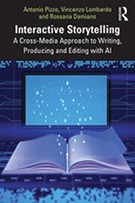 Interactive Storytelling: A Cross-Media Approach to Writing, Producing and Editing with AI
Interactive Storytelling: A Cross-Media Approach to Writing, Producing and Editing with AI
Antonio Pizzo, Vincenzo Lombardo, and Rossana Damiano. 2023. Routledge. [ISBN 978-1-0323-7164-1. 194 pages, including index. $44.95 (softcover).]
This co-authored guide to interactive storytelling is robust, detailed, and filled with multiple practical examples, references, and analyses for creating interactive stories. Except for the first and last chapters, the volume is not for beginners new to creating interactive media. These two chapters are readily excerpted for technology, writing, media, gaming, and instructional design courses.
The Introduction offers an important overview, defining interactivity, telling stories through different types of action as well as five important issues related to interactive stories. Thus, this provides an important working foundation and key frames for the rest of the text.
Chapter 3 covers dynamic elements and storytelling’s different units. The chapter also discusses dynamic elements and the agents as well as how these impact planning, conveying emotions, and the state of the game’s world. Chapter 4 addresses display: audience, system, and emotions. Two golden nuggets in this chapter: it addresses narratology versus ludology and interaction versus narration. These discussions could be excerpted for lower level or introductory courses on interactive fiction, storytelling, and gaming because of their brief but clear differentiation and identification of key concepts and issues.
Much of chapters 3–5 delve deeply into specific interactive storytelling engines, working with and optimizing databases, planning for plot generation, coding characters’ emotions, as well as supporting automation and simulation. This is not for beginners; however, it provides important guidance and best practices for more advanced interactive fiction readers, writers, and researchers.
Chapter 6 reviews 18 different games and interactive stories from the past half century. These descriptions and analyses start with Eliza (1966) and ends with Down the Rabbit Hole (2020). They also engage with well-known media like Myst (1993), The Walking Dead (2012), and Black Mirror: Bandersnatch (2018). Each review features roughly one page of description and one page of analysis. For each game, the authors focus on the story world, dynamic elements, engine, and display. These emphases do two things: (1) offer solid models for potential student reviews or analyses while providing a consistent structure for framing and critiquing individual interactive stories and games, and (2) build directly upon key concepts established earlier in Interactive Storytelling: A Cross-Media Approach to Writing, Producing and Editing with AI. These models could also be useful for educators working with educational games, game design, game analysis, storytelling, interactive fiction, and related topics. While the 18 reviews are persuasive and significant, most students would likely suffice with four to five of these reviews.
Interactive Storytelling is written for advanced or experienced experts or researchers familiar with interactive fiction technologies, methods, and platforms. Several chapters could easily be excerpted for less experienced learners and classes. New readers to interactive storytelling, gaming, or game design will want to read the Introduction, skip to Chapter 6 to read five to seven of the reviews, and then read the rest of the book to learn. Given the book’s accessible price, it could also scaffold skills and understanding for scholars and writers interested in interactive games and fiction.
Gregory Zobel
Gregory Zobel is an associate professor of Educational Technology at Western Oregon University.
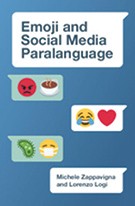 Emoji and Social Media Paralanguage
Emoji and Social Media Paralanguage
Michele Zappavigna and Lorenzo Logi. 2024. Cambridge University Press. [ISBN 978-1-0091-7980-5. 268 pages, including index. $34.99 (softcover).]
Emoji and Social Media Paralanguage is an excellent guide and model for increasing research and understanding of emoji in online communications and platforms. Whether or not readers are familiar with Systemic Functional Linguistics (SFL) corpora analysis, discourse analysis—Michele Zappavigna’s and Lorenzo Logi’s framing theory and research methods—the book holds many rewards for those working in the fields of web-based media and content. First, while showing the multiplicity of ways emoji construct and co-create meaning, the authors also offer a detailed and nuanced framework for analyzing graphical paralanguage. Next, several chapters are readily excerpted for advanced communications, rhetoric, media, and linguistic undergraduate or graduate classes. Third, multiple chapters provide excellent models for emoji-focused mini-replication studies.
Chapter 1 defines paralanguage, frames emoji as paralanguage, and then discusses the authors’ social semiotic perspective of emoji. This chapter also outlines the emoji corpora used for the research that is solidly excerptable.
Chapter 2 is fascinating in depth, range, and detail on semiotics and paralanguage for interested readers. It could potentially be used to educate students on how a research topic’s technical aspects, or unexpected variables or factors (emoji and Unicode) can help re/define how a research data set (corpora) are built. As the authors show, the Unicode determined multiple aspects to their research, which is a valuable lesson on research practice. The authors discuss emoji technical complexities ranging from their development, encoding, and organization and covers guidelines from the Unicode Consortium and other power structure challenges. This chapter also offers insight into how much work and adaptation is needed when researching ubiquitous communication media.
Chapter 3 moves directly to framing and analyzing relationships between text and emoji. Chapters 4–8 present detailed analyses—with plentiful images and explanatory diagrams—that focus on emoji-textual relations as they generate textual meaning, ideational meaning, interpersonal meaning, negotiating social bonds, and communing around social bonds. Those not familiar with linguistics, or SFL, might find these chapters challenging. These chapters’ clarity in order, argument, evidence, and analysis are excellent models for researchers new to emoji or considering related topics.
Chapter 9 is perhaps the most interesting to researchers and scholars working not in linguistics but related communication fields. It extends the authors’ earlier chapters to connect with other visual and graphical paralanguage like memes and GIFs. When combined with Chapter 1 and Chapter 10, the Conclusion, these opening and closing chapters broaden how we think about, frame, discuss, analyze, and employ emoji.
Gregory Zobel
Gregory Zobel is an associate professor of Educational Technology at Western Oregon University.
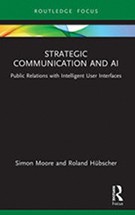 Strategic Communication and AI: Public Relations with Intelligent User Interfaces
Strategic Communication and AI: Public Relations with Intelligent User Interfaces
Simon Moore and Roland Hübscher. 2022. Routledge. [ISBN 978-0-367-62896-3. 102 pages, including index. US$26.99 (softcover).]
In Strategic Communication and AI: Public Relations with Intelligent User Interfaces, Simon Moore and Roland Hübscher ably discuss how an intelligent user interface (IUI) can be an important element in the future of digital communication with a focus primarily on public relations in a variety of applications.
The authors explain that an IUI is an interface that can use artificial intelligence to interact with a user. The reason artificial intelligence is used for interface design is to improve the efficiency and personalization of the interaction with the end user. Moore and Hübscher argue it is important to understand how the use of IUI could affect future communication and effectiveness as it relates primarily to public relations work. This could involve strategic communication via computers, displays, and phones as examples. It could also involve effective IUI-based communication in areas as diverse as community and corporate relations.
The scope of the topics covered in Strategic Communication and AI is impressive. For example, Moore and Hübscher discuss the use of IUIs in public relations that uses immersive communication. This includes virtual and augmented realities and an examination of the role, for example, of sight and touch. Visual worlds tie into sight with the idea that in the future “virtual and augmented spaces are going to be vivid and compelling” (p. 15). What are some examples in the world of public relations? One example is how travel and tourism companies might “engage with audiences and influencers by virtually immersing them in the experience of a destination” (p. 17). Another example is how companies could possibly “walk investors more persuasively through its latest restructuring” (p. 17). These examples just give an idea of the impressive scope and variety of topics covered in this book.
The scope of topics and related research in Strategic Communication and AI are also impressive as Moore and Hübscher debate important overarching questions such as “should governments regulate PR’s adoption of IUIs” (p. 82). Here, the authors explain how in 2021 the European Commission “produced a proposal for an Artificial Intelligence Act” (p. 82) and go on to provide in detail some specifics of the proposal. Moore and Hübscher have indeed done their homework here due to the level of detail. The list of related reading and reference material is impressive in both this section on adoption of government regulations and throughout the book.
Anyone interested in learning about IUIs or artificial intelligence will find something of value in Strategic Communication and AI: Public Relations with Intelligent User Interfaces.
Jeanette Evans
Jeanette Evans is an STC Associate Fellow; active in the Ohio STC community, currently serving on the newsletter committee; and co-author of an Intercom column on emerging technologies in education. She holds an MS in technical communication management from Mercer University and undergraduate degree in education.
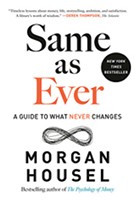 Same as Ever: A Guide to What Never Changes
Same as Ever: A Guide to What Never Changes
Morgan Housel. 2023. Portfolio/Penguin. [ISBN 978-0-593332-70-2. 240 pages. US$30.00 (hardcover).]
Same as Ever: A Guide to What Never Changes is a breezy book about the general truths of human behavior that stay the same through the ages. Given that “risk can never be mastered” (p. 20) and that many of the most consequential events both in the world and in our personal lives happen too unexpectedly to lend credence to any bold predictions about the future, Morgan Housel argues that we should therefore “base predictions on how people behave rather than on specific events” (p. 14). The self-contained chapters are well-suited to intermittent reading sessions, each focusing on a different observation about people and society that is as true today as it always has been, “same as ever.”
While the book is written for a general audience, technical communicators may find that their biggest takeaway from Same as Ever is an appreciation for the power and influence of stories. As much as we would like to think that the best, most factual or complete information will find a way to reach the masses, oftentimes “the best story wins” (p. 62). For example, there have been plenty of ship sinkings that were deadlier than the Titanic, but most people struggle to name them because those sinkings don’t have blockbuster movie stories behind them. Along those same lines, Housel notes that the bestselling anthropology book Sapiens by Yuval Noah Harari found massive success despite not contributing any new research to the field. It was thanks to Harari’s ability as a storyteller and assembler of information that his words resonated with so many.
Arguably, Same as Ever is like Sapiens in that its strength and value as a book lies not in any groundbreaking insights but instead in its ability to gather and distill common knowledge into a highly readable format. The entire chapter “It’s Supposed to Be Hard,” for example, could easily be summed up as the unremarkable adage “no pain, no gain.” As testament to his strength as a writer, Housel illustrates his admittedly banal lesson with the sensational and entertaining account of the Donner Party’s infamous resort to cannibalism resulting from a failed shortcut. Some of the author’s choices of anecdotes are more compelling than others. Warren Buffet’s mentioning that Snickers was the bestselling candy bar both in 1962 and during the struggling 2009 economy strikes me less as an encouraging, profound insight into the nature of eternal truths and more like an underwhelming appeal to authority, yet Housel thought this was a powerful enough anecdote to open the entire book. Still, I found that there were enough nuggets of wisdom and inspiration to make Same as Ever worthy of a long afternoon.
Josh Anderson
Josh Anderson, CPTC, is an Information Architect at Paligo. Josh was an English teacher in Japan and an SEO Specialist in the Chicagoland area before earning a Master of Information at the University of Toronto.
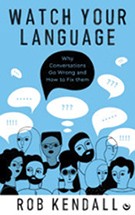 Watch Your Language: Why Conversations Go Wrong and How to Fix Them
Watch Your Language: Why Conversations Go Wrong and How to Fix Them
Rob Kendell. (2023). Watkins Publishing. [ISBN 978-1-78678-789-7. 224 pages. US$18.95 (softcover).]
Rob Kendall’s book Watch Your Language: Why Conversations Go Wrong and How to Fix Them is a foundational look into the learned art of conversations. This aptly titled guide specifically focuses on identifying why they may go wrong and what we can do to remedy the aftermath.
Kendell opens with a look into four outcomes of conversations gone wrong, upon which guidance for the rest of the book is structured. He defines these outcomes as (pp. 2–3):
- “The Tangle – where crossed wires lead to uncertainty and confusion, uncoordinated action and frustrated expectations.”
- “The Big Argument – where a convivial start spirals out of control and into a bitter row.”
- “The Bad Place – where the conversation you were having with someone has gone horribly wrong and you’re in the mire.”
- “The Lockdown – where feelings and thoughts are internalized…leading to an implosion.”
From then on, each chapter “is [a] short and self-contained [focus] on a specific topic with clear steps for action and a key lesson” (p. 4). Chapters with actionable titles range in topic from “Identify the Subtext” to “Ask What’s Missing and Needed”. To introduce the chapter, a short section of social research or Kendell’s personal experiences give additional context for upcoming information.
The main portion of the chapter begins with an example conversation from hypothetical characters, moving into an additional explanation of what outcome might be occurring. The “What To Do” section answers how the characters should have handled the situation and what we can do practically in our lives. Finally, the chapter ends with a short lesson, a perfect one-liner for the reader to take with them beyond the book.
Though the chapter sequence is repetitive, Watch Your Language is set up as a quick reference for specific situations and tips on how to handle them. At the beginning of the book, Kendell states, “I’d recommend reading the whole book and then returning to the chapters that you feel are most useful for you” (p. 4). With actionable chapter titles, readers can easily reference back to chapters they most need and find ways to work with others (or themselves) to better use the art of conversation. And, as technical communicators often work in various conversation settings, this guide is an easy in context reference.
Watch Your Language is a highly actionable guide for working with social situations in a variety of settings. With short, succinct chapters full of golden advice, all people would gain a better understanding of how to have better conversations, and work through situations in which conversations go wrong.
Lauren Rigby
Lauren Rigby is an STC student member at the University of Alabama in Huntsville. She is a first-year graduate student who is pursuing a master’s in English with a certificate in technical communication. Lauren is currently working towards becoming a technical communicator in the greater Huntsville area.
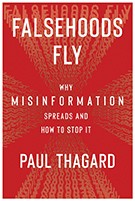 Falsehoods Fly: Why Misinformation Spreads and How to Stop It
Falsehoods Fly: Why Misinformation Spreads and How to Stop It
Paul Thagard. 2024. Columbia University Press. [ISBN 978-0-231-21395-0. 358 pages, including index. US$25.00 (softcover).]
Falsehoods Fly: Why Misinformation Spreads and How to Stop It takes its title from Jonathan Swift: “Falsehood flies and truth comes limping after it.” Since Swift’s day, technology has greatly increased our ability to learn accurate things about the world, but it has also accelerated the spread of misinformation to the point where, as in the case of the recent pandemic, it can kill millions.
To help us better deal with the problem, Paul Thagard, an emeritus professor of philosophy, offers a comprehensive theory and framework for understanding how information is generated and spread. He calls it the AIMS theory for its four main components: acquisition, inference, memory, and spread. Acquisition covers how we acquire information by interacting with the world, inference covers drawing conclusions from observations, memory covers storing and retrieving information, and spread covers disseminating what has been learned. For each area, Thagard describes how it can function well or poorly. For example, he shows how things can go awry through confirmation bias—looking for evidence that favors a predetermined position—or through motivated reasoning where people allow their fears, hopes, tribal membership, or preference for a given outcome to trump good information practice.
The problem of misinformation due to human error or carelessness is bad enough. The problem of disinformation—deliberate falsehoods—spread by irresponsible and malicious actors is often worse. Dishonest political and industry propagandists hide or twist evidence or “just make stuff up” for political or financial gain. Both can spread rapidly via social media platforms more concerned with revenue and engagement than accuracy and by other means.
Having laid out his theory, Thagard demonstrates its usefulness by applying it to four major areas rife with misinformation: the COVID-19 pandemic and vaccine hesitancy, climate change, conspiracy theories and political propaganda, and inequality and social justice matters.
To illustrate how the spread of misinformation might be combated, Thagard turns his attention to the news and propaganda flowing out of the Russia/Ukraine war. Against this background, he covers a range of techniques for misinformation self-defense, including replacing misinformation with good information, employing “motivational interviewing” which he defines as “using empathy and open-ended questioning to change attitudes and behaviors” (p. 286), and applying various critical thinking tools to become less susceptible to misinformation and its purveyors. Finally, he notes, addressing misinformation may require mending social media platforms and applying political and legal remedies to the worst offenders.
Rounding out his argument, Thagard closes with a series of critiques defending the idea of objective reality against various claims for a relativistic, post-truth world, such as the idea that all reality is socially constructed, or that we live in a virtual universe.
For those wanting more, Falsehoods Fly includes an extensive bibliography and a glossary of key concepts. Online supplements are available for those who want to dive into academic matters, or to take advantage of live links to references and notes.
Patrick Lufkin
Patrick Lufkin is an STC Fellow with experience in computer documentation, newsletter production, and public relations. He reads widely in science, history, and current affairs, as well as on writing and editing. He chairs the Gordon Scholarship for technical communication and co-chairs the Northern California technical communication competition.
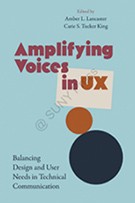 Amplifying Voices in UX: Balancing Design and User Needs in Technical Communication
Amplifying Voices in UX: Balancing Design and User Needs in Technical Communication
Amber L. Lancaster and Carie S. Tucker King, eds. SUNY Press. [ISBN 978-1-4384-9674-0. 480 pages, including index. US$99.00 (hardback).]
Amplifying Voices in UX: Balancing Design and User Needs in Technical Communication is the culmination of years of discussion about the diverse and sometimes competing audiences whom we address within our field. Specifically, who is our audience? What level of usability is “enough” to launch a product or website? When do we consider secondary and even tertiary audiences and how do we include them? In this edited collection, Amber L. Lancaster and Carie S. Tucker King seek to address these questions through a social justice lens.
The goal of Amplifying Voices in UX is to “extend UX design practices beyond translating and tailoring for local users to broader global users, while considering the diversity of user uniqueness, customization, desires, all stakeholders, and social needs” (p. xiii). This is an ambitious agenda in a corporate environment that tends to be driven by profit and the “best fit” for the general user over customization to adapt to the needs of the few. Fortunately, Lancaster, Tucker King, and the chapter authors make a compelling case for what they term equillibriUX: a state of balance between localization and usability and user experience (UX) (p. 6).
The book is divided into three sections, each addressing different stakeholders. Part 1: Pedagogical Topics addresses the ways in which instructors can design a curriculum within technical and professional communication that “emphasizes balance and empathy and integrating these values into our classrooms” (p. 19). Part 2: Rhetoric of Health and Medicine Topics emphasizes current developments in health communication such as user-centered tools and ways in which medical practitioners could foster patient-centered discourse. Finally, Part 3: Equality, Access, and Social Justice Topics presents “issues of equity, safety vulnerabilities, and civic engagement” (p. 325), such as the usability of ride-sharing apps and institutional transformation within a political campaign.
This tripartite focus is a strength of Amplifying Voices in UX in that it lets the reader consider usability within the context of a particular rhetorical situation. Usability is situated and cannot be discussed without consideration of the audience and the exigence of the application. However, Part 3 felt less focused and more like the miscellaneous bin of the book because the chapters lacked a cohesive central topic.
Amplifying Voices in UX would be a valuable resource for technical communicators and academics because there is not a single area within our field that UX doesn’t impact. The chapters lean toward academic rather than practical discourse, but the terms are clearly explained. The topics are sufficiently situated in real-world contexts to make this text a valuable addition to a graduate course in usability, a primer for current thought in UX for an academic, or as food for thought for practicing technical communicators.
Nicole St. Germaine
Nicole St. Germaine is a Professor of English and the Coordinator of the Technical and Business Writing Program at the Natalie Z. Ryan Department of English at Angelo State University.
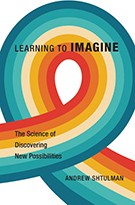 Learning to Imagine: The Science of Discovering New Possibilities
Learning to Imagine: The Science of Discovering New Possibilities
Andrew Shtulman. 2023. Harvard University Press. [ISBN 978-0-67-424817-5. 354 pages, including index. US$35.00 (hardcover).]
Knowledge is king as outlined in Learning to Imagine: The Science of Discovering New Possibilities. Through three well-defined sections, Andrew Shtulman proves that imagination is something that thrives through knowledge expansion and collaboration—experiences that come with age and education. This contradicts the assumption that children are more adept in creativity.
Shtulman brings to light how children cannot fully immerse themselves into imaginative worlds due to their limited knowledge. They insist on grounding their thoughts in reality and are unable to process universes that extend beyond their beliefs. For example, when children engage with fantasy and magic, they assign existing rationale to determine their level of engagement. Shtulman provides examples from pop culture, such as Harry Potter and Star Wars, to demonstrate the progression of character skill development—establishing plausibility. Children are more likely to believe incremental strategy and success, rather than swinging to ultimate power and victory of magical main characters. Natural progression and education make it so that children can establish plausibility that magic could be real in a fictional setting.
There is also a difference between the exploration of curiosity and imagination. These two can often be conflated and might lead to the assumption that children are greater at imagination than adults. As children are learning the world and boundaries around them, they are often asking the “how,” embarking on the exploration of curiosity. Through this line of questioning, they are determining how an event or item is plausible and building their understanding for future use. This exploration encourages collaboration between others and provides the tools to take a step toward creativity and imagination.
As adults, we find success in collaboration. We brainstorm ideas and can find ways to work smarter and more productively together. When we establish siloed experiences, we lose the imaginative ability and focus solely on hitting a deadline through relying on previous work that proved successful. Shtulman shares that examples can allow for creativity, but there is a flipside to becoming stagnant and not delivering innovation.
As I was reading this, I thought about speaking with friends who work in social media content development. They turn to their feeds to gain inspiration for their audience, only to realize they have spent hours endlessly scrolling and feeling overwhelmed with possibility. Their creativity feels drained, and they are back at square one, but now with depleted enthusiasm. This reflects how Shtulman discusses examples providing opportunity while simultaneously limiting how we can make it our own and go beyond the template. These friends often find they develop their best work when setting time limits for scrolling platform feeds and engaging in real-time conversations with others to share ideas.
Learning to Imagine is an insightful read on how knowledge is the foundation for imagination and how paired with collaboration, innovation, and success can thrive.
Siobhan Patterson
Siobhan Patterson is an STC member and is a communications consultant based in Auburn, AL. She has experience in working in telecommunications, fintech, sports communication, and higher education. Siobhan also serves as secretary on the local young professionals’ board and participates in her area bookstore challenges.
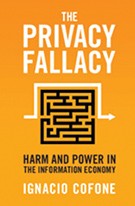 The Privacy Fallacy: Harm and Power in the Information Economy
The Privacy Fallacy: Harm and Power in the Information Economy
Ignacio Cofone. 2024. Cambridge University Press. [ISBN 978-1-316-51811-3. 280 pages, including index. US$120.00 (hardcover).]
When we tick the “I agree” box on a website, we believe we are signing a traditional contract ensuring that our information remains between us and the site, and that it cannot be shared with other sites without our further, express permission. In reality, the agreement does not prevent subsequent exploitation of the information by either the host site or third parties, who are free to use it as they please. Under the current legal regimen, the agreement we think protects our information actually enables its misuse.
Consider a recent case involving Facebook. Ordered by a court to remove an “‘ethnic affinity’ filter” that identified users by “race, gender, nationality, and other protected characteristics”, Facebook complied, but that did not “eliminate discrimination; it just hid it,” because advertisers could still filter indirectly—if not by “Latinx,” then by “who likes Telemundo.” By aggregating user information, Facebook can find ways to “discriminate while complying with antidiscrimination and privacy law” (p. 3).
The contractual consent agreement amounts to a “privacy fallacy” (p. 7) because we believe the procedural rules of a contract will protect us, when in practice “they’re insufficiently related to preventing harm” (p. 110). Personal information that “appears innocuous today” can be “harmful in the future” because, as in the Facebook example, we “can’t reveal just one thing without letting companies learn other things” (p. 8). The consequences of an initial, necessary, and straightforward transaction—providing basic information for permission to use a particular site—may actually be deeply and permanently injurious, and in ways the original user cannot foresee.
The solution, Ignacio Cofone argues in The Privacy Fallacy: Harm and Power in the Information Economy, is to shift the law from “a contracts paradigm” to “a torts paradigm” that imposes liability for violating “individual and social privacy” (p. 167) on the companies exploiting the data. A key premise is that information is “inevitably linked to us, like our bodies are,” and “like our bodies, are part of us, and what people do with them after an agreement impacts us, unlike what people do with commodities we give them” (p. 65).
Liability law introduces a self-correcting legal mechanism that shifts the burden to the data exploiter and avoids the impossible task of defining a set of procedural rules capacious and precise enough to foresee all possible abuses. Liability law also acknowledges that privacy harm isn’t binary, but “sits on a spectrum” (p. 19) and allows for adjusting damages on a case-by-case basis to achieve a just resolution.
With the advent of artificial intelligence, exploitation of private information increases exponentially and recedes even further from human control. The system operates globally, relentlessly, and autonomously, reinforcing the need “to curb privacy harm” (p. 172) by reclassifying online information agreements under tort law. Cofone’s recommendations could not be more relevant or timely.
Donald R. Riccomini
Donald R. Riccomini is an STC member and Emeritus Senior Lecturer in English at Santa Clara University, where he specialized in engineering and technical communications. He previously spent twenty-three years in high technology as a technical writer, engineer, and manager in semiconductors, instrumentation, and server development.
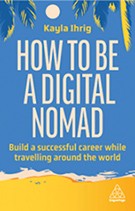 How to Be a Digital Nomad: Build a successful career while travelling around the world
How to Be a Digital Nomad: Build a successful career while travelling around the world
Kayla Ihrig. 2024. Kogan Page. [ISBN 978-1-3986-1305-8. 230 pages, including index. US$15.99 (softcover).]
Have laptop, will travel. If you read How to Be a Digital Nomad: Build a successful career while travelling around the world, you may be tempted to follow in Kayla Ihrig’s footsteps and trade in your 9-to-5 job for a one-way ticket to the wider world. Equal parts rah-rah, how-to, and beware, the book tackles the rewards and challenges of the digital nomad lifestyle. Ihrig dispenses colorful stories and counsel with a degree of good sense and compassion that can only come from experience.
The author provides a comprehensive guide on how to succeed in a location-independent job while exploring the world. Topics include where to look for remote work, how to prepare for going overseas, choosing where to stay, setting up your work life abroad, balancing work and travel, and preserving your mental health. She devotes an entire chapter to planning and managing finances abroad, with tips on how to estimate expenses when researching a new country and advice to always carry U.S. dollars.
Positioning herself as “your friend who works online and travels,” Ihrig acts as cheerleader and coach but does not shy away from the pitfalls of living and working abroad. “Every travel story starts the same: with something going sideways. It’s part of the adventure,” she writes (p. 199). She devotes an entire chapter to when things go wrong—whether technical problems that can bring work to a standstill, unexpected health problems, crime, or the burden of stress and loneliness. And yet, Ihrig identifies the biggest threats to travel and career plans as your own habits: lack of clarity, procrastination, and distracted working. She provides solid tips to combat these common saboteurs.
Remote work hygiene is another topic Ihrig explores in depth, which includes the all-important fundamentals of establishing file-naming conventions, staying on top of your inbox, being organized, and working ahead of schedule. “This is the only promise that I’ll make to you in this entire book,” Ihrig writes. “I can 100 per cent guarantee that poor remote work hygiene will detract from the enjoyment of your travels” (p. 99).
How to Be a Digital Nomad is an overall endorsement of the lifestyle, albeit told through a series of cautionary tales. The book’s beauty is in its smallest helpful details that explore all angles of digital nomadism, preparing new digital nomads to navigate problems and ascend peaks not yet imagined.
If you’re considering becoming a digital nomad, let this book help you get ready for one of the great adventures of your life with all its twists and turns. After all, as Ihrig reminds readers, “No one regrets traveling.”
Bonnie Denmark
Bonnie Denmark is an STC Member and Assistant Professor of Business and Technical Writing at Western Connecticut University. She has worked internationally as an educator and multimedia curriculum developer and made plenty of mistakes that this book would have helped her avoid.
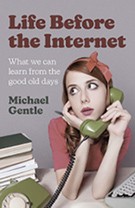 Life Before the Internet: What we can learn from the good old days
Life Before the Internet: What we can learn from the good old days
Michael Gentle. 2023. John Hunt Publishing. [ISBN 978-1-80341-388-4. 138 pages. US$15.95 (softcover).]
Michael Gentle examines everything from Amazon (the company, not the river) to penmanship in Life Before the Internet: What we can learn from the good old days. Each chapter of the book covers a specific customary practice or lack of in the past and how that impacted people for the better. I found the chapters “People Gave Us Their Full Attention” and “We Wrote Letters” to be particularly compelling accounts of skills that have been lost to time.
In “People Gave Us Their Full Attention,” Gentle talks about how in the pre-internet era, people’s attention wasn’t divided the way it is now. For example, “a restaurant was the one place where you were virtually guaranteed people’s full attention because it was impossible to be interrupted – except, of course, by the waiter coming round to ask if everything was okay” (p. 53). Now, our attention is divided by our laptop and cell, which deliver calls, texts, and notifications from various sources, and so is everyone around us. Further, these devices also give us quick access to a camera and social media allowing us to capture and share images and reviews of our meals for those who aren’t with us to appreciate. Gentle concludes, “Technology has effectively driven a wedge between our need to be connected and the attention we are willing to give to others” (p. 54). While technology has created the means for our divided attention, the true loss is that we’re rarely fully present.
In the “We Wrote Letters” chapter, Gentle discusses the near-instantaneous nature of communication today compared to the pre-internet era in which communication took time and forethought. “Before the internet, you kept in touch by writing letters. The process took weeks rather than minutes. Indeed, the very slowness of it all made letters very personal – and also valuable, because they couldn’t just be deleted” (p. 62). In the pre-internet era, communication was intentional: you thought about your words, wrote them down by hand, mailed them, and waited for a reply. When I read this chapter, I instantly longed to write letters to those I care about. But in a hyper-connected world, it’s an unrealistic communication form unless I can find someone willing to actively participate in this endeavor with me. Until I find such a person, I will continue writing hand-written thank-you and thinking-of-you notes to friends and family. I’m convinced that mail should be for more than bills and junk mail.
Gentle does an excellent job of breaking down some of the skills lost to time and technology and explaining why they are important. I would have liked him to also cover practical ways we might introduce these skills back into our lives and how technology has improved some things. With that said, Life Before the Internet is a good read for those of us who remember the pre-internet era (even if just barely) and those who never experienced it.
Sara Buchanan
Sara Buchanan works at London Computer Systems, a property management software company, in Cincinnati, OH. In her free time, she’s an avid reader, enjoys cooking, and doting on her cats: Buffy and Spike.
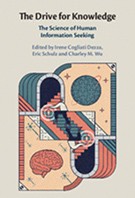 The Drive for Knowledge: The Science of Human Information Seeking
The Drive for Knowledge: The Science of Human Information Seeking
Irene Cogliati Dezza, Eric Schulz, and Charley M. Wu, eds. 2023. Cambridge University Press. [ISBN 978-1-009-01304-8. 292 pages, including index. US$35.99 (softcover).]
The Drive for Knowledge: The Science of Human Information Seeking comprises twelve scholarly articles describing the human need to seek knowledge and information. The book has three parts: Part I covers “What Drives Humans to Seek Information?;” Part II focuses on “How do Humans Search for Information?;” and Part III includes articles that focus on “What Machinery Supports the Drive for Knowledge?”
This book strives to answer core questions about our drive as humans to seek information, such as, “Where does this desire come from?,” “What is its purpose?,” and “How does it operate?.” The editors and the contributing authors try to answer these questions by including articles using the latest in tools and methodologies from computational models of human information-seeking behavior to neuro-imaging techniques.
In one article, “From Curiosity to Interest: Accumulated Knowledge Supports Long-Term Persistence of Information-Seeking Behavior,” Ed Donnellan, Michiko Sakaki, and Kou Murayama provide a brief overview of two research traditions—interest research and curiosity research—and then attempt to provide a framework to connect their strengths. On one hand, interest research is primarily an educational perspective that is qualitative in nature and seeks to discover facts about information-seeking behavior over the long-term. On the other hand, curiosity research is a perspective that is quantitative in nature and seeks facts about one-time information seeking.
Both traditions focus on people’s motivations (not those based on immediate, extrinsic incentives such as food or money), and try to explain the relationship between a person’s pre-existing knowledge and their information-seeking. The authors propose a new framework that incorporates reward-learning and knowledge acquisition. Their main points are that knowledge accumulation: (1) creates awareness of gaps in knowledge; (2) increases information-seeking skills (or perceived skills); and (3) increases the expectation of reward value of new information (meaning that greater value will be applied to information pertaining to an already existing knowledge base).
Another article, “Edgework: Viewing Curiosity as Fundamentally Relational” by Perry Zurn, et al., begin by asking “What is curiosity?” Their theory is that curiosity is not simply a desire for knowledge to fill in information gaps, but it is a grasping for information that fundamentally connects relationships between ideas in the mind and things in the world. Theirs is a connectional model. In their research, curiosity is the “edgework” of the knowledge-building process. They think that curiosity as edgework also works nicely with the theory of “compression progress” (p. 265) or that we, as humans, enhance the compactness, efficiency, and flexible use of knowledge and may prioritize this type of knowledge as we continue to develop and age.
Other articles provide a wide variety of theoretical perspectives on memory, reinforcement and human social learning, attention control, and even what makes a good query. The Drive for Knowledge is best suited for learning and development practitioners within technical communication.
Charlotte Weddington
Charlotte Weddington is an STC member and has been a technical communicator in the manufacturing sector since 2015. She has a background in ISO 9001 documentation and currently works for Hunter Douglas as a Technical Writer.
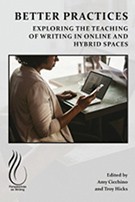 Better Practices: Exploring the Teaching of Writing in Online and Hybrid Spaces
Better Practices: Exploring the Teaching of Writing in Online and Hybrid Spaces
Amy Cicchino and Troy Hicks, eds. 2024. The WAC Clearinghouse and University Press of Colorado. [ISBN 978-1-64215-224-1. 504 pages. US$0.00 (e-book). Free download from WAC Clearinghouse website at https://wac.colostate.edu/books/perspectives/better/]
Better Practices: Exploring the Teaching of Writing in Online and Hybrid Space investigates effective writing teaching strategies for digital and hybrid learning environments. It emphasizes the importance of moving beyond traditional “best practices” to embrace a nuanced approach that acknowledges the diverse realities of technology-based instruction. This research aims to develop flexible, inclusive, and student-centered strategies in response to the unique challenges of online and hybrid writing instruction. The article adopts a collaborative model, pairing experts with newcomers in the field of online writing instruction. This approach fosters dialogue, the exchange of ideas, and open collaborative scholarship. The hope is to contribute to the field of writing studies by offering insights and strategies that help teachers and students excel in the digital age.
The research identified gaps in the understanding of online writing instruction (OWI) and online literacy instruction (OLI), as well as their best practices. Previous literature often focused on idealized “best practices,” neglecting the complex realities of their implementation in digital environments. This article proposes refined practices as a solution. These practices, rooted in OWI/OLI principles, emphasize students’ active participation in their learning process. Such practices are crucial for developing an effective, equitable writing pedagogy that adapts to diverse student needs and addresses the specific challenges of online and hybrid learning.
Amy Cicchino and Troy Hicks focus on informed practices shaped by a deep understanding of the field. Their solutions consider students’ diverse needs as well as the complexities of online and hybrid learning environments. This student-centered approach is an improvement over previous works that often overlooked the role of learners. This book organizes itself around concepts that direct a range of educational experiences, offering readers various avenues to investigate particular OWI/OLI themes and goals. This work’s scholarly contributions lie in its exploration and advocacy of improved practices for teaching writing in online and hybrid learning environments. The authors propose a nuanced approach that addresses the complexity of OWI and OLI, emphasizing accessibility, inclusivity, and intentional support for student collaboration. This collaborative effort addresses the needs of the field while challenging the traditional expert-beginner dichotomy and providing diverse pedagogical experiences. By integrating refined practices, collaboration, and a focus on accessibility and inclusiveness, Cicchino and Hicks effectively address existing problems in online writing instruction. While the article does not delve into simulation-based research or specific methodologies, it offers valuable insights into how to enhance writing instruction in online and hybrid spaces.
Better Practices is a valuable resource for anyone interested in transitioning from traditional “best practices” to a nuanced, student-centered, collaborative, and technology-aware approach to creating effective and equitable online and hybrid writing instruction. The book is well-written and easy to follow, making it accessible to a wide range of readers.
Danang Handoko Belut Saputro
Danang Handoko Belut Saputro is an awardee of the Lembaga Pengelola Dana Pendidikan (LPDP) PK-176 scholarship for a master’s degree in information technology at the Universitas Gadjah Mada in Indonesia. He is grateful to LPDP for providing complete financial support for his master’s degree and this book review.
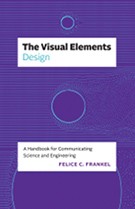 The Visual Elements–Design: A Handbook for Communicating Science and Engineering
The Visual Elements–Design: A Handbook for Communicating Science and Engineering
Felice C. Frankel. 2024. University of Chicago Press. [ISBN 978-0-226-82916-6. 186 pages. US$20.00 (softcover).]
Felice C. Frankel is back with a second book in her Visual Elements series, The Visual Elements–Design. Like its predecessor on photography, Frankel wrote this for science and engineering professionals to help them learn to communicate their work effectively to a broad range of audiences. The Visual Elements–Design is an outstanding resource with thoughtful analysis of the best practices intended for anyone interested in improving their communication through information visualization.
The introduction sets up the content well and explains why visuals are important in publishing and presenting scientific research. Chapter 1, “Listing and Sketching,” covers the value of planning out your ideas before you get started and explains that when you jump into the software first, it “will influence your thinking” and “the program’s defaults [will] push you toward certain layouts” (p. 12) , which is excellent advice. Chapter 2, “Case Studies,” provides a vast collection of examples that focus thematically on structural, conceptual, and numerical graphic representations. These case studies are beneficial because, besides offering a wealth of successful solutions, they also include the various iterations the designs went through as they determined the final form and why they decided to make changes. This shows the deep thought and analysis that goes into successful design.
Chapter 3, “Graphic Submissions,” includes more examples provided by friends, colleagues, and designers or scientists known by Frankel, with the stories behind the design in their own words. This section is organized by color, composition, layering, labeling, and refining. The last chapter, “Posters and Slide Presentations,” was a pleasant surprise to see; the design of research posters and presentations, especially in the academic setting, seems to be overlooked, but here again, the advice about the importance of design in these settings is spot on. Frankel continuously reminds readers, “If graphics play such a critical role in publishing…why are they not taken more seriously?” (p. 184).
Like the first book in the series, the contents of The Visual Elements–Design are very approachable. The handbook’s heart is the abundant examples with clear explanations of each design decision, and while Frankel gives specific details about what she thinks works and doesn’t work in the various iterations, she also challenges the reader to think about whether they agree with her assessments, acknowledging that there is a level of subjectivity in design.
While not covered in this handbook, Frankel does mention the discussion on ethics from The Visual Elements–Photography book. You would need to read both books in the series to understand these concepts. Thankfully, they are both quick reads with beneficial content. Also similar to the first book, this is a helpful guide to keep handy to refer back to when needed.
Amanda Horton
Amanda Horton holds an MFA in Design and teaches graduate and undergraduate courses at the University of Central Oklahoma (UCO) in design history, theory, and criticism. She is also the director of the Design History Minor at UCO.
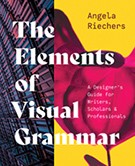 The Elements of Visual Grammar: A Designer’s Guide for Writers, Scholars & Professionals
The Elements of Visual Grammar: A Designer’s Guide for Writers, Scholars & Professionals
Angela Riechers. 2024. Princeton University Press. [ISBN 978-0-691-23122-8. 222 pages, including index. US$24.95 (softcover).]
The Elements of Visual Grammar: A Designer’s Guide for Writers, Scholars & Professionals is a book about graphic design crafted for people who haven’t studied graphic design. The book’s purpose is to teach the big principles of design to those who need on-the-job strategies for using images and illustrations combined with text. Given the simple but thorough explanations and the plethora of full-color images, the text succeeds in its mission.
Angela Riechers broke the book into two sections: the basics and strategies. The Basics section covers the “grammatical” terms of graphic design. In Chapter 1, you learn how to choose the right image for a text, giving particular attention to why and how images pull in readers. Here, she demonstrates what story an image tells and what qualities of the image impact the viewer. Riechers offers six “baseline rules” for choosing an image, with supporting sample images and their contexts. She ends the chapter with questions to help strategize your image-selection process.
Chapters 2 and 3 explore image composition and action (“active surfaces”) with topics from hierarchy, balance and scale to rhythm, movement, and point of view. Chapter 4 covers color theory by acknowledging the complexities of color while reassuring the reader that “it isn’t necessary to know all the voluminous information on color to use it wisely” (p. 75). The information comes to the reader in small, easily-consumable chunks, with bullet lists, clear and simple definitions, and images that support the text.
The Strategies section covers the purpose of those graphical elements. Is a photo chosen to convey information or to “shock or outrage” viewers? Riechers examines photographic work and illustrations separately here to illuminate the differences of each medium. Use photographs for journalism, and illustrations to diagram or visualize data; both have artistic purposes. She includes lists of questions to help focus the decision-making processes that are practical and immediately useful, again giving the target audience what it needs.
The final chapter uses humor to integrate all the lessons. When choosing photos, Riechers writes that “the first pancake is almost always a throwaway” (p. 185), meaning don’t go with the first choice and play a little to experience the impacts of other images, too.
The only minor issues with the text are that the table of contents lists only the chapter titles and not the section headings, while the index uses a run-in style that makes it awkward to find things.
Riechers writes directly and openly in a conversational tone: “With that said, always pull a wider selection than you think you’ll need […], but don’t go crazy” (p. 17). This approach to the writing doesn’t shy from the technical: She defines and uses terms like “chromostereopsis,” which is the “illusion of vibration” caused by colors. Riechers prose is easily readable and comprehensible when she talks about color theory, hue, saturation, and other graphical design terms. Given the target audience, her use of a friendly tone and style is an excellent choice.
Kelly A. Harrison
Kelly A. Harrison, MFA, teaches technical communication at Stanford University and has taught a range of writing courses at San José State University. Before her career as an academic, she spent over 15 years in computer software as a technical writer, editor, and manager. She writes, edits, and consults, and she is working on a masters of liberal arts at Stanford University.
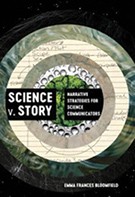 Science v. Story: Narrative Strategies for Science Communicators
Science v. Story: Narrative Strategies for Science Communicators
Emma Frances Bloomfield. 2024. University of California Press. [ISBN 978-0-520-38082-0. 288 pages, including index. US$29.95 (softcover).]
Narratives are powerful. They make information easier to understand and remember, and they shape what we believe and how we act in the world. But they can also stir our emotions, and they can sometimes lead us astray. For this reason, some in science have come to shun narrative—“Don’t tell me a story, just show me the data.” Hence the book’s title.
In Science v. Story: Narrative Strategies for Science Communicators, Emma Frances Bloomfield argues that this antipathy to arguing via narrative leaves science communicators at a disadvantage. When forced to contend with a stirring narrative—a tale of biblical creation, an seductive conspiracy theory, or disingenuous claims from corporate-backed “merchants of doubt,”—a dispassionate presentation of scientific findings, when not backed by a strong narrative, will often fail to gain traction.
To hold up their end of the discourse, science communicators need to become better at tailoring narratives to meet the needs of specific audiences. Toward this end, Bloomfield offers a framework that enables one to look at a narrative’s elements—content, character, action, sequence, storyteller, and scope—along with how they are implemented, and map them onto a web for further analysis. This framework allows one to play with how the story is told and judge how it might resonate with a particular audience: could it be improved by introducing relatable characters, telling it from a different viewpoint, or using a more local focus, and so on? While Bloomfield stresses that no one size fits all, in general she recommends using a mix of personalized elements, concrete details, and big-picture elements. Personal stories and concrete examples are easier for most audiences to grasp and relate to, while more expansive elements add a degree of universality and broad importance.
Bloomfield uses her own tool to describe and analyze the discourse surrounding four scientific controversies: the COVID-19 pandemic, climate change, evolution, and vaccination. She provides excellent summaries of the complex discourse surrounding each. Quoting from scientific sources and from those offering rival narratives, Bloomfield contrasts how the various rivals have attempted to make their case. For the most part, science attempts to avoid emotion, and argues using facts, logic, charts, and statistics. While the proponents of rival narratives often seek to undercut the science with various strategies, some of them disingenuous—emotional appeals, cherry-picked citations, personal attacks on the storyteller (“flip-flop Fauci”), charges of political bias or financial corruption, and so on. Science communicators need to be prepared for such rival narratives, tropes, and tactics.
Bloomfield reminds us that to tell better stories, science communicators also need to be better listeners. Not all rival narratives are disingenuous. Some rival stories may need to be listened to, such as those from indigenous and marginalized communities that may contain truths that dominant narratives have overlooked. Listening may allow rivals to at least agree on some common ground.
Science v. Story is original, well argued, and well worth consideration, not just for scientists, but for anyone who participates in helping science hold up its end of the discourse that shapes our lives.
Patrick Lufkin
Patrick Lufkin is an STC Fellow with experience in computer documentation, newsletter production, and public relations. He reads widely in science, history, and current affairs, as well as on writing and editing. He chairs the Gordon Scholarship for technical communication and co-chairs the Northern California technical communication competition.
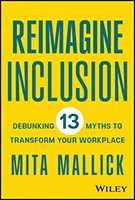 Reimagine Inclusion: Debunking 13 Myths To Transform Your Workplace
Reimagine Inclusion: Debunking 13 Myths To Transform Your Workplace
Mita Mallick. 2024. John Wiley & Sons. [ISBN 978-1-394-17709-7. 268 pages, including index. US$28.00 (hardback).]
Mita Mallick notes that she knows what it is like to feel left out. She explains this is why she devoted her professional life to encouraging inclusion in the workplace. Mallick was employed as a multicultural marketer in the beauty and consumer goods space, then worked with companies such as Carta, AVON, Pfizer, and Johnson & Johnson to promote inclusion. Her focus in Reimagine Inclusion: Debunking 13 Myths To Transform Your Workplace is to offer practical strategies to promote inclusivity and show how what she calls myths can hold back an organization from being inclusive.
An example of a myth, as explained by Mallick, concerns apologies related to incidents involving inclusion. The myth is that “we do not owe anyone an apology.” Instead, an organization should recognize when an apology is in order and provide one. A real apology is related to a statement recognizing remorse over something bad happening and real actions related to preventing the problem in the future. In the cases Mallick discusses, what is bad is that inclusion was not evident, exclusion happened, and harm occurred.
Mallick explains how Starbucks, Sesame Street, Sephora, and other organizations effectively handled apologies when harm occurred due to a lack of inclusion. Sephora, for example, issued an effective statement of apology. Sephora also followed up by providing a certain percentage of products for black and brown customers. Sephora also hired a certain percentage of black and brown employees and held sessions on inclusion. Mallick considers their statement and follow up to be a good way to handle an apology recognizing that “something bad” happened.
Mallick also explains in Reimagine Inclusion that inclusion is good for business. She ably provides data about this to help explain why inclusion is an important issue in the business world today and in society in general.
A leader or manager looking to encourage inclusion in the workplace could benefit from reading about helpful and specific actions in Reimagine Inclusion. A student, teacher, researcher, or anyone interested in the topic of diversity, equity, and inclusion will also find something of interest.
Jeanette Evans
Jeanette Evans is an STC Associate Fellow; active in the Ohio STC community, currently serving on the newsletter committee; and co-author of an Intercom column on emerging technologies in education. She holds an MS in technical communication management from Mercer University and undergraduate degree in education.
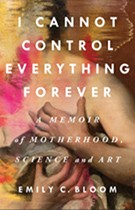 I Cannot Control Everything Forever: A Memoir of Motherhood, Science, and Art
I Cannot Control Everything Forever: A Memoir of Motherhood, Science, and Art
Emily C. Bloom. 2024. St. Martin’s Press. [ISBN 978-1-250-28568-3. 334 pages, including index. $29.95 (hardback).]
Anyone involved in practicing, researching, or teaching about technical communication (and consequently wanting to connect effectively with their audience) should find of interest how Emily C. Bloom insightfully discusses in I Cannot Control Everything Forever: A Memoir of Motherhood, Science, and Art that a person in today’s world increasingly relies on scientific and technical data. Also of interest would be Bloom’s look at the history of science and how scientific discoveries have made us rely so much on scientific data. This insight can help the technical communicator better connect with an audience and aim to provide to a user information that is clear and useful.
How did the world get to be so data-driven and interested in science and technology? In an attempt to answer this question, Bloom looked at snippets of the history of science to help make sense of the current world as she includes such subjects as the identification and treatment of diabetes, and development of ultrasounds touching many lives with their technology and related data. As to why people today are data-driven and interested in technology, consider how a home Covid test—now an option but not always so—provides a technology and data of life-changing importance.
In a section on the history of science, Bloom discusses Alexander Graham Bell’s important work with the hearing impaired. Her description of Bell’s work is especially engrossing as she explains how his mother and wife were both deaf and an influence on his work. Bloom also points out in an interesting narrative that Bell had talent not only in science but also in poetry, music, and art. Her narrative brings a humanistic perspective on her observations as she reflects on a combination of interests in science, literature, and art. I Cannot Control Everything Forever is what can be called a meditation on science that also brings in pieces of art.
Bloom is the mother of an exceptional child as she notes that the term “scientific motherhood” (p. 12) applies today as she needs to often look at scientific data to make decisions concerning the care of her child. Being a great communicator and engrossing storyteller, Bloom has an interest in the intersection of science and art—a great perspective for someone involved in technical communication and looking at how best to serve today’s often data-driven audience.
Jeanette Evans
Jeanette Evans is an STC Associate Fellow; active in the Ohio STC community, currently serving on the newsletter committee; and co-author of an Intercom column on emerging technologies in education. She holds an MS in technical communication management from Mercer University and an undergraduate degree in education.
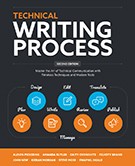 Technical Writing Process: Master the Art of Technical Communication with Timeless Techniques and Modern Tools
Technical Writing Process: Master the Art of Technical Communication with Timeless Techniques and Modern Tools
Alison Pickering, et al., ed. 2024. (2nd ed.) Boffin Education. [ISBN 978-0-9941693-2-7. 494 pages. US$34.95.(softcover).]
Technical Writing Process: Master the Art of Technical Communication with Timeless Techniques and Modern Tools, 2nd ed. provides a comprehensive overview of the steps in many technical writing processes. The book divides information into 11 sections with the first describing the profession and offering insights about starting or advancing your career. It includes testimonials from current technical communicators. The remaining sections explain the tactical processes and flow of technical writing from a planning section to editing and publication. Some sections focus on specific aspects like translation and management.
The book reads like a textbook in a good way. It neatly separates information into teachable units and follows plain language principles and well formatted chapters. Each chapter lists its target audience with many chapters focusing on aspiring or beginning technical writers, career advancers, and cross-domain professionals. Some of the lessons share tips that could take years to learn. For example, providing understandable objectives for each reviewer so that subject matter experts are reviewing documents for content with no punctuation.
Notable in this second edition are the references to artificial intelligence (AI) and its role in technical communication. The authors mention it throughout the book and devote a chapter to practical ways to use (and not use) AI in your work. For example, they recommended using it as a means to streamline the technical writing process but cautioned that feeding proprietary information into this technology could be cause for termination if done without necessary approvals. In reference to current debates about AI replacing human workers, the authors took an optimistic approach and reminded readers that technical writing often focuses on ideas and innovations that are not yet documented, thus have not been incorporated into AI training sets.
A few drawbacks to this edition are the lack of color for the visuals and testimonials as it reduced their effectiveness. Also, the authors touted it as a textbook but did not include an index. The publisher provides additional resources online for a fee. That said, as a seasoned technical communicator, I appreciate the authors’ inclusion of tools that have made my life easier (SnagIt, Trello, etc). I will recommend this book to new technical communicators and teams without designated documentation specialists.
Stephanie Saylor
Stephanie Saylor is a usability engineer and technical communicator from Maryland. She received her master’s degree in digital communication from Johns Hopkins University.
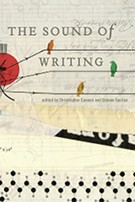 The Sound of Writing
The Sound of Writing
Christopher Cannon and Steven Justice, eds. 2024. Johns Hopkins University Press. [ISBN 978-1-4214-4725-4. 278 pages, including index. US$54.95 (softcover).]
Christopher Cannon and Steven Justice have collected ten historical essays in The Sound of Writing that explore the concept of what readers hear in their heads as they read classic literature, like Dante’s Inferno and Chaucer’s Canterbury Tales. This 250-page collection is misleading in length as each essay contains between 2–14 pages of referenced citations or referenced musical passages.
The authors open with an introduction that draws the reader into the concept of intersecting senses. Ancient writings of Aristotle trace the notion that the senses are intertwined or even inseparably conjoined. “Aristotle likened all sensation to the impression of an object into a piece of wax because he thought that whatever we see or hear (or taste or smell), we also touch, since every bodily perception is a mode of ‘contact’” (p. 1). Some of Aristotle’s observations reappeared in later works by Herder and even the opera composer Wagner. And even before Aristotle, the concept of sound in writing was observed in the cryptographic pictures of caves. Cannon and Justice contrast the approach of understanding sound from cave pictures with the concept of understanding sounds of the first letters coming together to form the Phoenician alphabet. That contrast introduces the purpose of every essay to explain their method of interpreting sound.
Sarah Nooter in her essay explores sound through the seeming silence of women in ancient Greek literature by tracing their epigrams and epitaphs—inscriptions written by women about the dead. She discovers the voices of these ancient Greek women “speaking through statuary, inscribed in verse, quoted as song, and depicted as rising from an entombed corpse” (p. 34).
Sarah Kay’s essay uses medieval songs encouraging us to “read with our ears”(p. 40) because sound is depicted by a phonograph making an impression on wax. She connects that with Aristotle’s explanation of how the senses intertwine by making an impression on one another.
Several essays explore medieval literature with the patterns of rhythm and sound in writing that may require having a formal education in world literature and poetry. Some of the vocabulary and discussion goes behind what an amateur might comprehend. One example is the discussion around speaking and the role of silence in Dante’s Inferno. Another is the essay about the “final e” in the role of Middle English literature.
The last essay in the collection, “Writing Reading Rhythm,” is the most helpful essay to read for an educated reader not specialized in historical literature and prose. Christopher Hasty explains in contemporary terms the components of sound included in modern writing, specifically rhythm. “In a world of literary artifacts, institutions, and practices, ‘the sound of writing’ can be heard as a reminder of the rhythmic energy and fluidity of sounding and resounding waves of writing and perhaps be heard, too, as a call for new ways of describing such processes in general and in particular” (p. 252). This statement is an appropriate conclusion to The Sound of Writing.
Julie Kinyoun
Julie Kinyoun is an on-call chemistry instructor at various community colleges in Southern California. An avid reader, she enjoys reviewing books that help her become a better educator.

